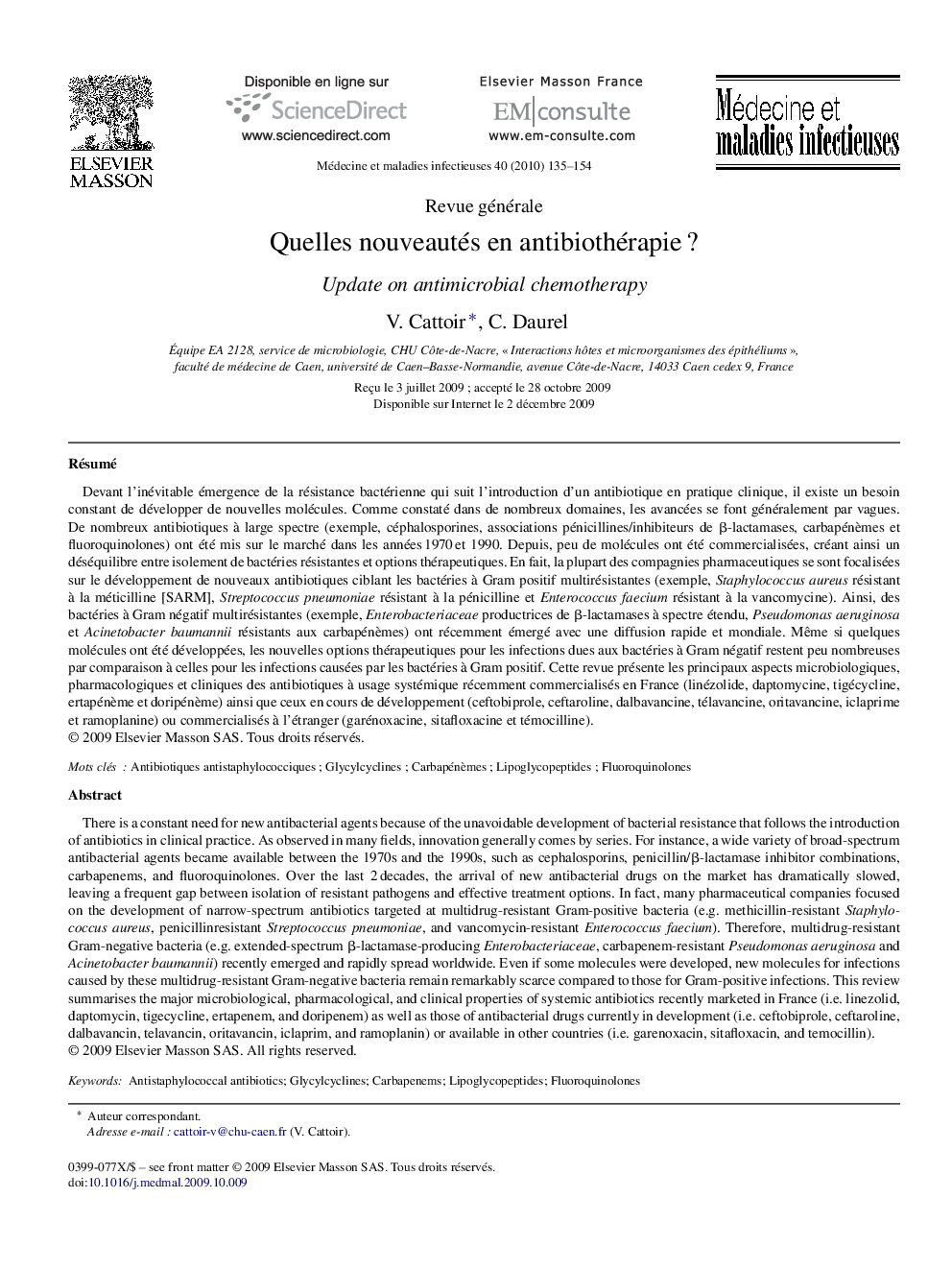| کد مقاله | کد نشریه | سال انتشار | مقاله انگلیسی | نسخه تمام متن |
|---|---|---|---|---|
| 3413495 | 1224296 | 2010 | 20 صفحه PDF | دانلود رایگان |

RésuméDevant l’inévitable émergence de la résistance bactérienne qui suit l’introduction d’un antibiotique en pratique clinique, il existe un besoin constant de développer de nouvelles molécules. Comme constaté dans de nombreux domaines, les avancées se font généralement par vagues. De nombreux antibiotiques à large spectre (exemple, céphalosporines, associations pénicillines/inhibiteurs de β-lactamases, carbapénèmes et fluoroquinolones) ont été mis sur le marché dans les années 1970 et 1990. Depuis, peu de molécules ont été commercialisées, créant ainsi un déséquilibre entre isolement de bactéries résistantes et options thérapeutiques. En fait, la plupart des compagnies pharmaceutiques se sont focalisées sur le développement de nouveaux antibiotiques ciblant les bactéries à Gram positif multirésistantes (exemple, Staphylococcus aureus résistant à la méticilline [SARM], Streptococcus pneumoniae résistant à la pénicilline et Enterococcus faecium résistant à la vancomycine). Ainsi, des bactéries à Gram négatif multirésistantes (exemple, Enterobacteriaceae productrices de β-lactamases à spectre étendu, Pseudomonas aeruginosa et Acinetobacter baumannii résistants aux carbapénèmes) ont récemment émergé avec une diffusion rapide et mondiale. Même si quelques molécules ont été développées, les nouvelles options thérapeutiques pour les infections dues aux bactéries à Gram négatif restent peu nombreuses par comparaison à celles pour les infections causées par les bactéries à Gram positif. Cette revue présente les principaux aspects microbiologiques, pharmacologiques et cliniques des antibiotiques à usage systémique récemment commercialisés en France (linézolide, daptomycine, tigécycline, ertapénème et doripénème) ainsi que ceux en cours de développement (ceftobiprole, ceftaroline, dalbavancine, télavancine, oritavancine, iclaprime et ramoplanine) ou commercialisés à l’étranger (garénoxacine, sitafloxacine et témocilline).
There is a constant need for new antibacterial agents because of the unavoidable development of bacterial resistance that follows the introduction of antibiotics in clinical practice. As observed in many fields, innovation generally comes by series. For instance, a wide variety of broad-spectrum antibacterial agents became available between the 1970s and the 1990s, such as cephalosporins, penicillin/β-lactamase inhibitor combinations, carbapenems, and fluoroquinolones. Over the last 2 decades, the arrival of new antibacterial drugs on the market has dramatically slowed, leaving a frequent gap between isolation of resistant pathogens and effective treatment options. In fact, many pharmaceutical companies focused on the development of narrow-spectrum antibiotics targeted at multidrug-resistant Gram-positive bacteria (e.g. methicillin-resistant Staphylococcus aureus, penicillinresistant Streptococcus pneumoniae, and vancomycin-resistant Enterococcus faecium). Therefore, multidrug-resistant Gram-negative bacteria (e.g. extended-spectrum β-lactamase-producing Enterobacteriaceae, carbapenem-resistant Pseudomonas aeruginosa and Acinetobacter baumannii) recently emerged and rapidly spread worldwide. Even if some molecules were developed, new molecules for infections caused by these multidrug-resistant Gram-negative bacteria remain remarkably scarce compared to those for Gram-positive infections. This review summarises the major microbiological, pharmacological, and clinical properties of systemic antibiotics recently marketed in France (i.e. linezolid, daptomycin, tigecycline, ertapenem, and doripenem) as well as those of antibacterial drugs currently in development (i.e. ceftobiprole, ceftaroline, dalbavancin, telavancin, oritavancin, iclaprim, and ramoplanin) or available in other countries (i.e. garenoxacin, sitafloxacin, and temocillin).
Journal: Médecine et Maladies Infectieuses - Volume 40, Issue 3, March 2010, Pages 135–154